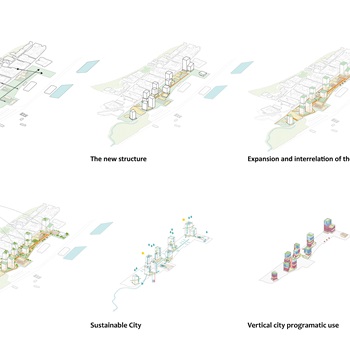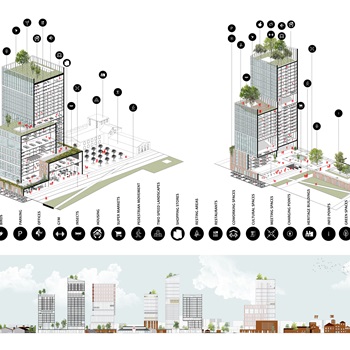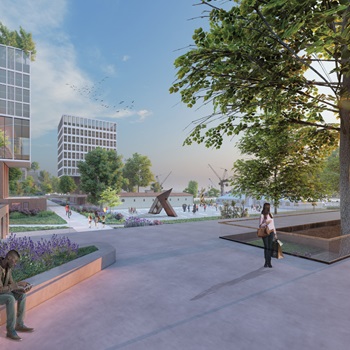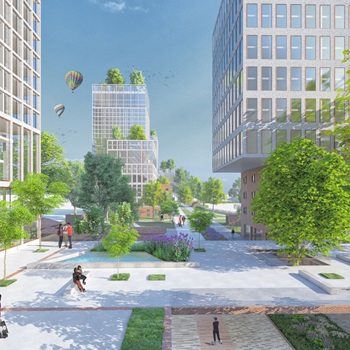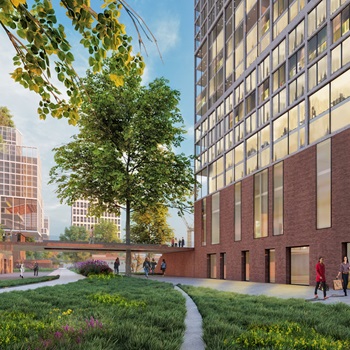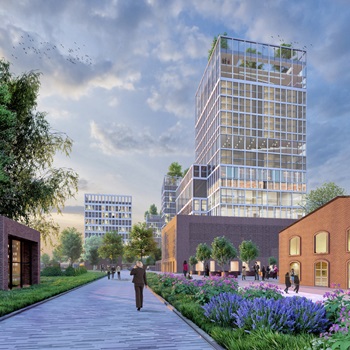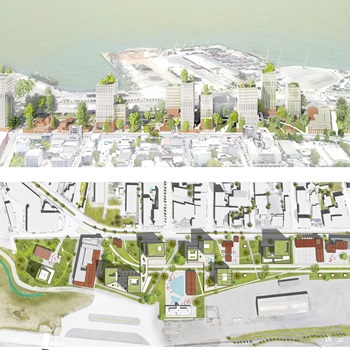
5th prize: Interview with Maria – Chrysoula Akrivou & Antonis Athanasiou
1) Please tell us a few words about you and what motivated you to participate in the competition of Arxellence 2. Did you ever undertake/design a similar project (CBD) in the past?
a. Tell us a few words about the team that worked on the proposal.
The team consists of two members: Maria – Chrysoula Akrivou & Antonis Athanasiou.
Maria – Chrysoula is an Architect with a diploma in Architecture from University of Patras, Greece and she also holds a Master degree in Landscape Architecture from Technical University of Delft, Netherlands. Maria was always interested in the relation between architecture, urbanism and landscape. During her master studies in Landscape Architecture at TU Delft University she managed to experiment in this relationship and enrich her previous background as an Architect with landscape architecture knowledge.
Notions, such as landscape as infrastructure, habitat types, gradients, flows and water management, triggered her interest leading in the realization of her thesis project that focuses on the Riverscapes and their relation with the urban fabric and the surrounding landscape types integrated with the role of the architectural elements. That is also the reason why her master thesis was honored with a grant by Stichting NHBos.
Maria had several office collaborations and competition entries with prize winning and distinctions in International and Greek architectural competition and she is currently living and working in the Netherlands, in the field of landscape architecture and her knowledge of both architecture and landscape architecture enables her to work on different assignments and scale levels.
Antonis is an Architect with a master’s degree from department of Architecture University of Patras Greece and currently a Landscape architect with a master’s degree from TU Delft University in Netherlands. As an architect Antonis has several office collaborations and competition works with prize winning and distinctions in International and Greek architectural competitions.
As a student of TU Delft Landscape Department and a former architect he was always interested on the integration of both fields taking into consideration their complexity during the design projects. His thesis was also granted by Stichting NHBos and honored by TU Delft for the national Archiprix best thesis selection. Antonis is currently working in both fields of landscape architecture and architecture and focuses on a multiscalar approach into his projects. His work presents a strong and unique language bridging the gap between urban strategies and landscape interventions, promoting a more sustainable design process taking into consideration the societal and ecological factors, as well as the architectonic elements into an interchanging system of processes.
b. Did you ever undertake/design a similar project in the past?
We have participated in a lot of competitions individually or as a team, but we had never work on such a unique project with these relations, uses and historical / industrial characteristics.
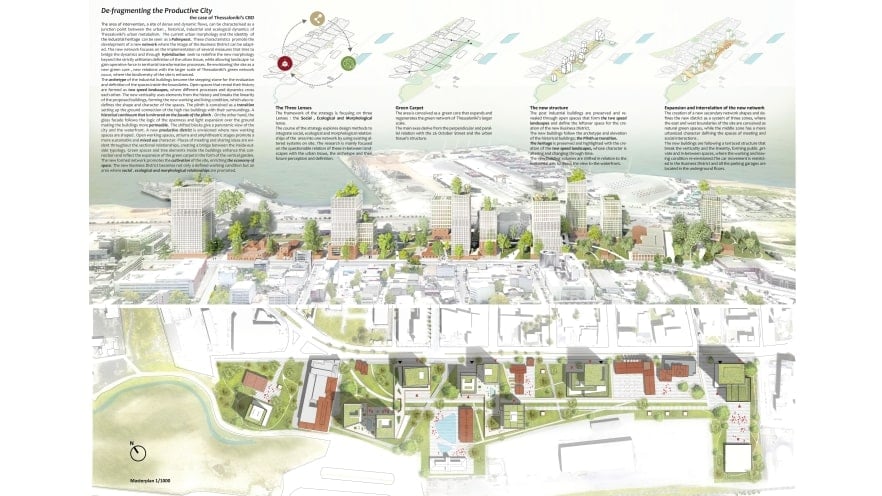
2) Could you give us a description of your proposal? How did you approach the project and what was the main idea of your design?
a. Describe in a few words the structure of the CBD you designed (the main characteristics of your synthesis).
The proposed CBD goes beyond the functional character and promotes an interchanging network, where a mixed use program determines the working - living relations. Open working spaces, atriums, amphitheatric stages, places of meeting and sharing ideas are creating a bridge between inside- outside typology. In between spaces, the Two Speed Landscapes, are used as transitional zones, highlighting the importance of the heritage buildings, as well as the future of the site, by transforming it through time. Green spaces and tree elements inside the buildings enhance this connection and reflect the expansion of the green carpet in the form of the vertical garden. At the same time the new envisioned CBD is closely related with the waterfront as a green continuum, but also uses different Scales and densities creating a direct dialect with the Thermaic gulf. The new formed network promotes the cultivation of the site, enriching the economy of space.
b. Describe the main idea of your proposal.
The area of intervention is a site of dense and dynamic flows that can be characterized as a junction point between the urban, historical, industrial and ecological dynamics of the larger urban metabolism. The current urban morphology and the identity of the industrial buildings can be seen as a Palimpsest. These characteristics promote the development of a new network where the image of the Business District is adapted. This new network focuses on the implementation of several measures that tries to bridge the dynamics and through hybridization seek to redefine the new morphology beyond the strictly utilitarian definition of the urban tissue, while allowing landscape to gain operative force in territorial transformation processes.
Re-envisioning the site as a new green sponge new relations with the larger scale of Thessaloniki’s green network occur, where the biodiversity of the site is enhanced. The Archetype of the heritage buildings becomes the stepping stone for the evaluation and definition of the spaces inside the boundaries. Open spaces that reveal their history are formed as Two Speed Landscapes where different processes and dynamics cross each-other. The new verticality takes elements from the history and breaks the linearity of the proposed buildings forming the new working and living condition, which also defines the shape and character of the spaces. The Plinth is seen as a transition setting up the ground connection of the high rise buildings with their surroundings. A historical continuum that is mirrored on the facades of the plinth.
On the other hand, the glass façade follows the logic of the openness and light expansion over the ground making the buildings more permeable. The shifted blocks give a panoramic viewing of the city and the waterfront. A new productive district is envisioned where new working spaces are shaped. Open working spaces, atriums and amphitheatric stages promote a more sustainable and productive character. Places of meeting and sharing ideas are evident throughout the sectional relationships creating a bridge between inside - outside typology. Green spaces and tree elements inside the building enhance this connection and reflect the expansion of the green carpet in the form of the vertical garden. The new formed network promotes the cultivation of the site enriching the economy of space. On the other hand, the glass façade follows the logic of the openness and light expansion over the ground making the buildings more permeable. The shifted blocks give a panoramic viewing of the city and the waterfront. A new productive district is envisioned where new working spaces are shaped. Open working spaces, atriums and amphitheatric stages promote a more sustainable and productive character. Places of meeting and sharing ideas are evident throughout the sectional relationships creating a bridge between inside - outside typology. Green spaces and tree elements inside the building enhance this connection and reflect the expansion of the green carpet in the form of the vertical garden. The new formed network promotes the cultivation of the site enriching the economy of space. These relationships can be seen when you cross through the CBD and you experience the interaction with the history, the old and the new.
How nature gains an operative force shaping the new CBD which becomes a destination, a point of reference for Thessaloniki’s city, a meeting place which you can visit, experience, pass by or live. The elevated gardens and landscapes giving new horizontal and vertical connections.
The new Business District becomes not only a defined working condition, but an area where social, ecological and morphological relationships are promoted. A green continuum of the waterfront. A pragmatic approach for the future of this important area for the city of Thessaloniki.
c. What difficulties did you face?
One of the main difficulties we faced during the design process was how could the image of the CBD be adapted in a site where the importance of the industrial buildings and the history of place are evident. How could such a dense program and high rise buildings be envisioned in such a way that would not affect the ‘’topos’’ but at the same time have a direct dialect with the waterfront, an important urban, social and economic part for the city of Thessaloniki.
d. What would you say is the most innovative feature of your proposal?
The introduction of the Plinth as a transition mirroring the history of the topos in the proposed buildings as well as its materialization is one of the tools that makes this proposal innovative. At the same time the principle of the transition is evident not only in terms of architectural programmatic use, but also in the new formed urban space and scales.
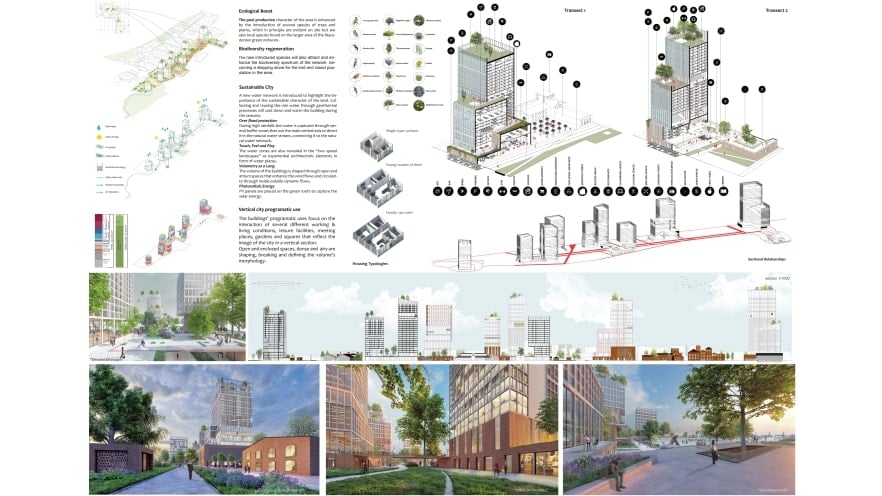
3) What do you think made your idea stand out and why? What are the experiences you gained from the competition of ArXellence 2?
The goal of the proposal was to highlight Thessaloniki’s waterfront industrial zone, an area of dense and dynamic flows, and envision it as a focal point for the city of Thessaloniki. The vision focuses on these interrelations and considering the “minimal intervention” into each layer, without neglecting the history and the importance of the archetype, created a new network that used the vertical layer as the main driving force, during the design process. Notions such as the Archetype, the Plinth, the Two Speed Landscapes as well as the relation between the proposed Scales made this design idea to stand out.
The biggest experience that we gained from this competition is without doubt to understand how a CBD works and how can its image be adapted and integrated to a site specific urban context, but at the same time how the architectural and landscape design processes are able not only to form a new “topos” but also highlight its historical values.
